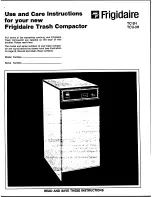
INTRODUCTION
•
Brakes are inoperative when manually released for repair or maintenance purposes. Use blocks or similar de-
vices to secure the machine in these conditions.
•
Only use specified towing points for towing the machine. Connect parts carefully. Make sure that all pins and/or
locks are secured in position before applying traction. Never remain near the towing bars, cables or chains that
are operating under load.
•
When loading or unloading the machine from the trailer (or other means of transport), select a flat area capable
of sustaining the trailer or truck wheels. Firmly secure the machine to the truck or trailer and lock the wheels in
the position used by the carrier.
•
Electric heaters, battery-chargers and similar equipment must only be powered by auxiliary power supplies with
efficient ground insulation to avoid electrical shock hazards.
•
Always use suitable hoisting or lifting devices when raising or moving heavy parts.
•
Keep bystanders away.
•
Never use gasoline, diesel oil or other inflammable liquids as cleaning agents. Use non-inflammable, non toxic
commercially available solvents.
•
Wear safety goggles with side guards when cleaning parts with compressed air.
•
Do not run the engine in enclosed spaces without suitable ventilation or exhaust extraction.
•
Never use open flames for lighting when working on the machine or checking for leaks.
•
All movements must be carried out carefully when working under, on or near the machine. Wear personal pro-
tective equipment (P.P.E.): helmets, goggles and special footwear.
•
When carrying out checks with the engine running, request the assistance of an operator in the driver's seat.
The operator must maintain visual contact with the service technician at all times.
•
If operating outside the workshop, position the machine on a flat surface and lock in position. If working on a
slope, lock the machine in position. Move to a flat area as soon as is safely possible.
•
Damaged or bent chains or cables are unreliable. Do not use them for lifting or towing. Always use suitable
protective gloves when handling chains or cables.
•
Chains should always be safely secured. Make sure that the hitch-up point is capable of sustaining the load in
question. Keep the area near the hitch-up point, chains or cables free of all bystanders.
•
Maintenance and repair operations must be carried out in a CLEAN and DRY area. Clean up any water or oil
spillage immediately.
•
Do not create piles of oil or grease-soaked rags as they represent a serious fire hazard. Always store rags in a
closed metal container.
•
Before engaging the machine, make sure that there are no persons within the machine or implement range of
action.
•
Empty your pockets of all objects that may fall accidentally unobserved into the machine inner compartments.
•
When metal parts are sticking out, use protective goggles or goggles with side guards, helmets, special footwear
and gloves.
•
When welding, use protective safety devices: tinted safety goggles, helmets, special overalls, gloves and
footwear. All persons present in the area where welding is taking place must wear tinted goggles. NEVER
LOOK DIRECTLY AT THE WELDING ARC WITHOUT SUITABLE EYE PROTECTION.
•
Always disconnect battery ground terminal when welding.
•
Metal cables tend to fray with repeated use. Always use suitable protective devices (gloves, goggles, etc.) when
handling cables.
84479138A 06/06/2011
12
Summary of Contents for PUMA 130
Page 4: ...84479138A 06 06 2011 Find manuals at https best manuals com...
Page 5: ...INTRODUCTION 84479138A 06 06 2011 1 Find manuals at https best manuals com...
Page 19: ...INTRODUCTION ZEIL06CS0136F0A 2 ZEIL06CS0135F0A 3 84479138A 06 06 2011 15...
Page 26: ...INTRODUCTION 84479138A 06 06 2011 22...
Page 61: ...This as a preview PDF file from best manuals com Download full PDF manual at best manuals com...
















































